Seibu Railway
 | |
Native name | 西武鉄道株式会社 |
|---|---|
| Private KK | |
| Industry | Private railroad |
| Founded | December 21, 1894 |
| Headquarters | 1-1-1 Kusunokidai, Tokorozawa-shi, Saitama-ken, Japan |
Area served | Tokyo and Saitama whichi are Japan. |
Key people | President: Takashi Goto |
| Services |
passenger railways other related services |
| Owner | Seibu Holdings (100%) |
Number of employees | 3,289 (as of the end of 2004) |
| Website |
www |
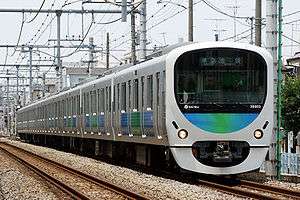

Seibu Railway Company, Ltd. (西武鉄道株式会社 Seibu Tetsudō Kabushiki-gaisha) is a conglomerate based in Tokorozawa, Saitama, Japan, with principal business areas in railways, tourism, and real estate. Seibu Railway's operations are concentrated in northwest Tokyo and Saitama Prefecture; the name "Seibu" is an abbreviation of "west Musashi", referring to the historic name for this area. However it and its holding company hold shares of numerous bus, hotel and tourism operations nationwide.
History
"Seibu Railway" was originally the name of a tram service between Shinjuku and Ogikubo, which was transferred to the Tokyo metropolitan government in 1951 and eventually closed in 1962. The Seibu Railway was acquired in 1921 by the Kawagoe Railway, which had operated a train service between Kokubunji and Kawagoe since 1894; the merged company kept the "Seibu" name and expanded its main line to Takadanobaba, forming what is now known as the Seibu Shinjuku Line.
The current Seibu Railway is a product of a 1945 merger between the former Seibu Railway and the Musashino Railway, which was founded in 1912 to operate what is now known as the Seibu Ikebukuro Line. The merger was largely orchestrated by Yasujirō Tsutsumi, a real estate developer who opened the Tamako Railway (now the Seibu Tamako Line) in 1928, became a major shareholder in the Musashino Railway and merged the two in 1940.
In 1944, the Tokyo metropolitan government, under the administration of Shigeo Ōdachi, hired the Seibu Railway and the Musashino Railway to provide a coordinated service to transport night soil from central Tokyo to outlying disposal areas. At the time, night soil was generally transported by truck to Tokyo Bay and disposed of by dumping there, but the progress of World War II led to gasoline and personnel shortages which made this system unsustainable. The sewage service continued through the American occupation until 1951. As a result of this service cooperation, Seibu Railway merged with Musashino Railway to form the current Seibu Railway, effective in September 1945. Tokyu Group president Keita Goto had an intense personal rivalry with Tsutsumi, and unsuccessfully attempted to block both Tsutsumi's takeover of the Musashino Railway and its merger with the Seibu Railway.[1]
The former Seibu network based around Shinjuku and the former Musashino network based around Ikebukuro remain operationally separated today. In 1986, Seibu Railway moved its headquarters from the Ikebukuro area to Tokorozawa, Saitama, where the two main Seibu lines intersect.
Tsutsumi became the controlling shareholder in Seibu Railway following the merger through his holding company Kokudo Corporation. After gaining control of Seibu, Kokudo developed the Prince Hotels chain, acquired the baseball team now known as the Saitama Seibu Lions, in addition to continuing its core real estate business throughout the Tokyo area. Seibu Railway had its initial public offering on the Tokyo Stock Exchange in 1949 but remained under the control of Tsutsumi through Kokudo.
Station numbering was introduced on all Seibu Railway lines during fiscal 2012.[2]
Delisting and takeover struggle
Tsutsumi registered Seibu Railway shares owned by Kokudo in the names of various affiliated individuals, often without their permission, so that the true ownership of the company was not readily apparent.[3] Following the death of Tsutsumi in 1964, his third son Yoshiaki Tsutsumi inherited control of Kokudo and continued the practice of falsifying shareholder records. His holdings in Kokudo and Seibu led to his being deemed the "world's richest man" by Forbes magazine for four consecutive years from 1987 to 1990, with estimated net worth of $15-20 billion during the height of the Japanese asset bubble. He was arrested on securities fraud charges in March 2005.[4]
On December 21, 2005, Seibu Railway was delisted from the Tokyo Stock Exchange. A reorganization of the group, completed in February 2006, created Seibu Holdings to act as a holding company for both the railway and Prince Hotels. Cerberus Capital Management, an American investment fund, became the largest shareholder in Seibu Holdings with a 29.9% share of the new company.
In late 2012 and early 2013, Cerberus proposed that Seibu Railway abolish five non-core lines, along with other restructuring measures throughout the Seibu Holdings group, but management refused to implement these changes. Cerberus then executed a tender offer to increase its stake to 35% as of June 2013, giving Cerberus the power to veto shareholder resolutions.[5] Cerberus had aimed to raise its stake to 44%, bringing it closer to an outright majority, but Seibu management engaged in a massive campaign to thwart the tender offer, including advertising within Seibu trains to passengers who owned stock. The East Japan Railway Company and several financial institutions also planned a support scheme to keep Cerberus from acquiring control of Seibu, but it was ultimately not implemented due to a lack of potential financial benefit for the investors. At the June 2013 shareholder meeting, several proposals by Cerberus were voted down, including the election of outside directors and the abolition of non-core lines.[6]
As of June 2013, Yoshiaki Tsutsumi remains a major investor in Seibu Holdings through his 36% investment in NW Corporation, the second-largest shareholder in the company with a share of around 15%. Tsutsumi refused to respond to the Cerberus tender offer at the urging of Seibu management.[6]
Railway operations
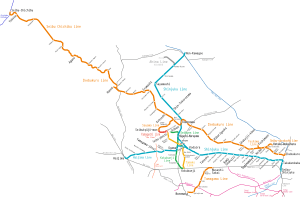
Seibu's routes total 179.8 km. They fall into two separate groups. Tokorozawa Station is the crossing point of Ikebukuro Line and Shinjuku Line.
Seibu Railway is well known for its bright yellow colored trains. However, more recent trains have a blue colored line on unpainted stainless steel or aluminium bodies.
Ikebukuro Line Group
The Ikebukuro Line group includes the Ikebukuro Line and its branches.
- Ikebukuro Line: Ikebukuro Station—Tokorozawa Station—Hannō Station—Agano Station (57.8 km)
- offers direct "through-service" via the Seibu Yūrakuchō Line to: Shin-Kiba Station on the Tokyo Metro Yūrakuchō Line and Motomachi-Chūkagai Station on the Minatomirai Line via the Tōkyū Tōyoko Line and the Tokyo Metro Fukutoshin Line.[7]
- Seibu Chichibu Line: Agano Station—Seibu Chichibu Station (19.0 km)
- Seibu Yūrakuchō Line: Nerima Station—Kotake Mukaihara Station (2.6 km)
- connects the Ikebukuro Line and the Tokyo Metro system
- Toshima Line: Nerima Station—Toshimaen Station (1.0 km)
- Sayama Line: Nishi-Tokorozawa Station—Seibu-Kyūjō-mae Station (4.2 km)
Shinjuku Line Group
The Shinjuku Line group includes the Shinjuku Line and its branches, as well as the Tamagawa Line, which is not a branch of the Shinjuku Line but had been owned by the Shinjuku Line's operator before its merger with the Ikebukuro Line operator.
- Shinjuku Line: Seibu Shinjuku Station–Tokorozawa Station–Hon-Kawagoe Station (47.5 km)
- Seibu-en Line: Higashi-Murayama Station—Seibu-en Station (2.4 km)
- Haijima Line: Kodaira Station—Haijima Station (14.3 km)
- Tamako Line: Kokubunji Station—Hagiyama Station—Seibu Yuenchi Station (9.2 km)
- Kokubunji Line: Higashi-Murayama Station—Ogawa Station—Kokubunji Station (7.8 km)
- Tamagawa Line: Musashi-Sakai Station—Koremasa Station (8.0 km)
- Ahina Line (安比奈線): Minami-Ōtsuka Station—Ahina Station (3.2 km: Former freight line, closed)
People mover
Rolling stock
As of 1 April 2015, Seibu operates a fleet of 1,274 electric multiple unit (EMU) vehicles.[8]
- Seibu 101 series (since 1969)
- Seibu 2000 series (since 1977)
- Seibu 4000 series (since 1988)
- Seibu 6000 series (since 1992)
- Seibu 9000 series (since 1993)
- Seibu 10000 series (since 1993)
- Seibu 20000 series (since 2000)
- Seibu 30000 series (since 2008)
 101 series
101 series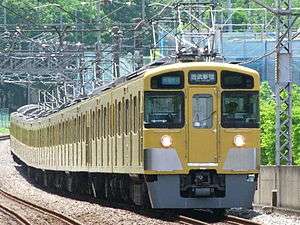 2000 series
2000 series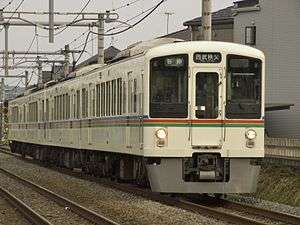 4000 series
4000 series 9000 series
9000 series
Future rolling stock
A fleet of eight ten-car Seibu 40000 series EMUs is scheduled to be introduced from spring 2017, operating on the Seibu Ikebukuro, Seibu Shinjuku, and Seibu Haijima Lines.[9]
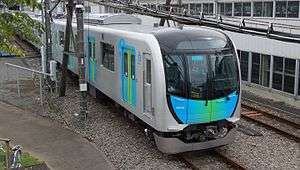 The first 40000 series EMU delivered in September 2016
The first 40000 series EMU delivered in September 2016
A new fleet of seven eight-car limited express trains (56 vehicles in total) is scheduled to be introduced during fiscal 2018 and 2019. The new trains are to be built by Hitachi, with the design and styling overseen by architect Kazuyo Sejima.[10]
Former rolling stock
- Seibu 3000 series (1982-2014)
- 3000 series
Fares
Single fare (Adult)
|
|
|
|
Affiliated companies
- Prince Hotels
- Seibu Construction
- Seibu Bus
- Saitama Seibu Lions (baseball team)
- Seibu Dome
- Seibu Real Estate
- Seibu Trading
References
- ^ The Japan Times (December 22, 2005), Seibu Railway shareholders OK reorganizing plan. Retrieved December 22, 2005.
- ↑ "Postwar60: Seibu's shareholding methods turn into minefield", Kyodo News, January 13, 2005, retrieved June 26, 2013
- ↑ 西武線全駅で駅ナンバリングを導入します [Station numbering to be introduced at all Seibu stations] (pdf). News Release (in Japanese). Japan: Seibu Railway. 23 February 2012. Retrieved 10 February 2013.
- ↑ "Kokudo faked names of all shareholdings when Seibu debuted in 1949", Kyodo News, March 15, 2005, retrieved June 26, 2013
- ↑ "Tycoon Tsutsumi -- from world's richest man to detention cell", Kyodo News, March 3, 2005, retrieved June 26, 2013
- ↑ "Cerberus Boosts Seibu Stake but Misses Goal", Wall Street Journal, June 1, 2013, retrieved June 26, 2013
- 1 2 "西武TOB攻防に幻の「助っ人」", 日本経済新聞, pp. 朝刊 総合2, June 26, 2013, retrieved June 26, 2013
- ↑ "2013 年 3 月 16 日(土)ダイヤ改正を実施します" [A revision to train operations to be enforced on March 16, 2013 (Sat)] (PDF). Retrieved August 11, 2013.
- ↑ 私鉄車両編成表 2015 [Private Railway Rolling Stock Formations - 2015] (in Japanese). Japan: Kotsu Shimbunsha. 23 July 2015. p. 203. ISBN 978-4-330-58415-7.
- ↑ 進化した”スマイルトレイン” 西武鉄道、新型車両「40000系」デビューへ [New Seibu 40000 series "advanced Smile train" rolling stock to debut] (in Japanese). Japan: Tetsudo Shimbun. 24 August 2015. Retrieved 25 August 2015.
- ↑ 西武鉄道 2018年度に新型特急車輌導入 [Seibu Railway to introduce new limited express trains in fiscal 2018]. Tetsudo Hobidas (in Japanese). Japan: Neko Publishing Co., Ltd. 14 March 2016. Retrieved 14 March 2016.
External links
| Wikimedia Commons has media related to Seibu Railway. |
- Seibu Railway website (Japanese)
- Seibu Railway website